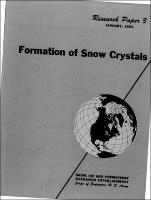Please use this identifier to cite or link to this item:
https://hdl.handle.net/11681/2727| Title: | Formation of snow crystals |
| Authors: | Nakaya, Ukichirō, 1900-1962 |
| Keywords: | Snow Snowflaks Snow crystals Snow crystal formation Ice crystals Classification |
| Publisher: | U.S. Army Snow, Ice, and Permafrost Research Establishment. Engineer Research and Development Center (U.S.) |
| Series/Report no.: | Research report (U.S. Army Snow |
| Description: | Research Report Abstract: It is proposed that crystals of ice formed in the air be classified into snow crystals proper and ice crystals. The germs of snow crystals formed at high altitude and ice particles obtained by seeding are grouped as ice crystals. The relationship between meteorological conditions and crystal formation should be investigated separately for these two types. This classification will serve to eliminate possible confusion of the two types of crystals. Experiments conducted by making various types of snow crystal proper artificially have shown that needles, irregular needles, and cup crystals are formed in the region of supersaturation above water saturation, while columns and spatial assemblies of plates are produced in the region between water and ice saturations. Dendritic crystals and the two kinds of plates appear both in conditions of supersaturation with respect to water and supersaturation with respect to ice. In the snow-making apparatus, numerous minute droplets appear in the range of supersaturation with respect to water. They are about 1 micron in diameter and behave like water vapor in condensing on ice surfaces. The number of these minute droplets agrees well with the total concentration of nuclei in air as measured by previous investigators. Study of the variety in shape of ice crystals obtained by seeding, examined in the light of our knowledge of artificial snow production, and electron-microscope study of the snow crystal nucleus give rise to a new theory of snow crystal formation. First the ice crystal is formed by spontaneous transformation of a supercooled droplet at cirrus temperature; or by natural or artificial seeding at higher temperatures; or by direct condensation of water vapor on a solid nucleus. Then snow crystals proper grow from these ice crystals, which act as germs. Most snow crystals proper are made not only by sublimation of water vapor, but also by condensation of minute droplets on these ice crystals. Most commonly, the minute water droplets are formed on the condensation nuclei during supersaturation with respect to water. The peculiar action of the minute water droplet in condensing, like water vapor, on the ice crystal surface may be due to the surface diffusion of H2O molecules. The metamorphism of snow particles on the ground is assumed by many workers to be chiefly due to surface diffusion of H20 molecules. It is suggested that similar surface phenomena take place in the formation of snow crystals in the air. |
| Rights: | Approved for public release; distribution is unlimited. |
| URI: | http://hdl.handle.net/11681/2727 |
| Appears in Collections: | Research Report |
Files in This Item:
| File | Description | Size | Format | |
|---|---|---|---|---|
| SIPRE-Research-Report-3.pdf | 10.48 MB | Adobe PDF |  View/Open |